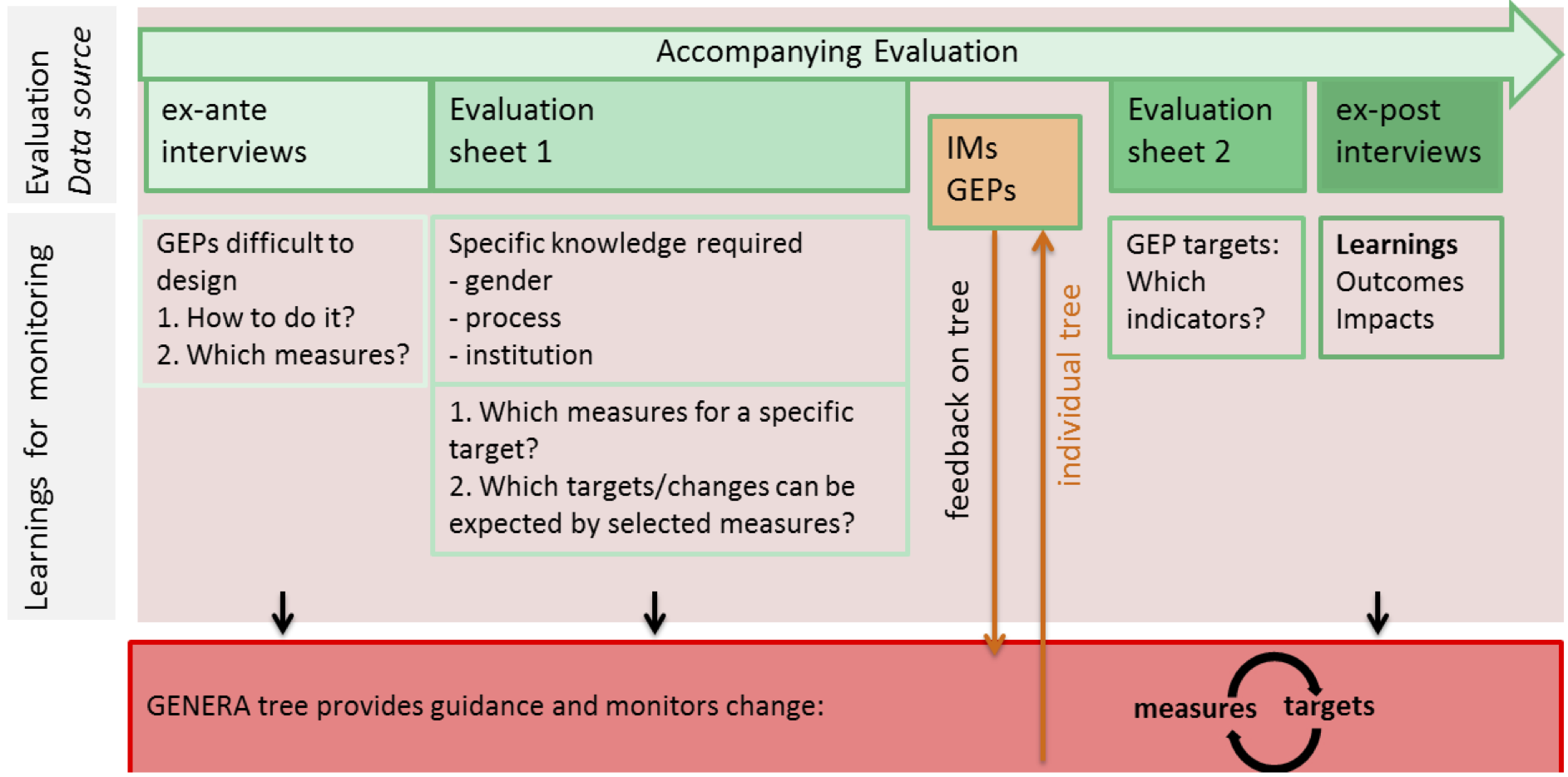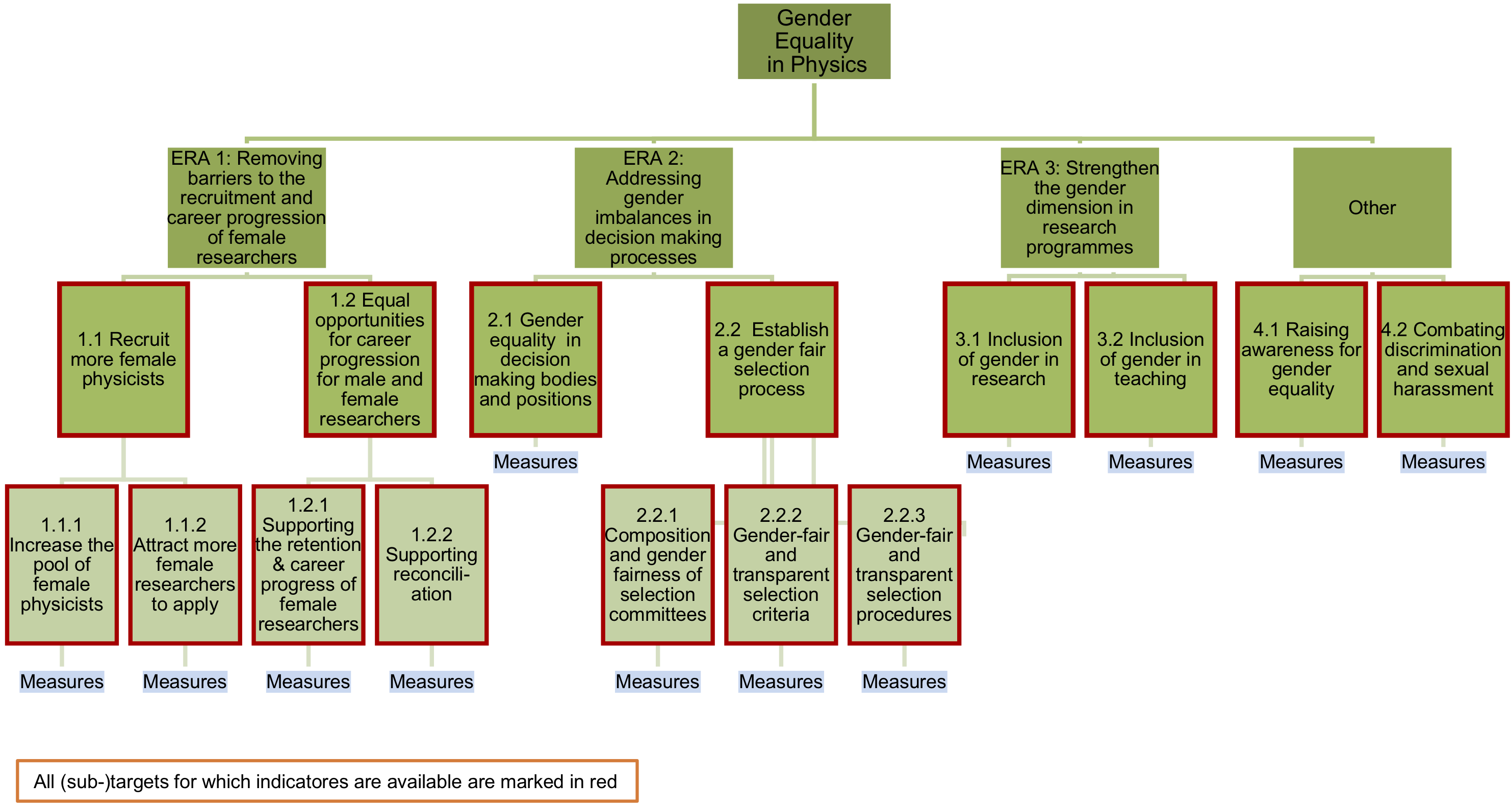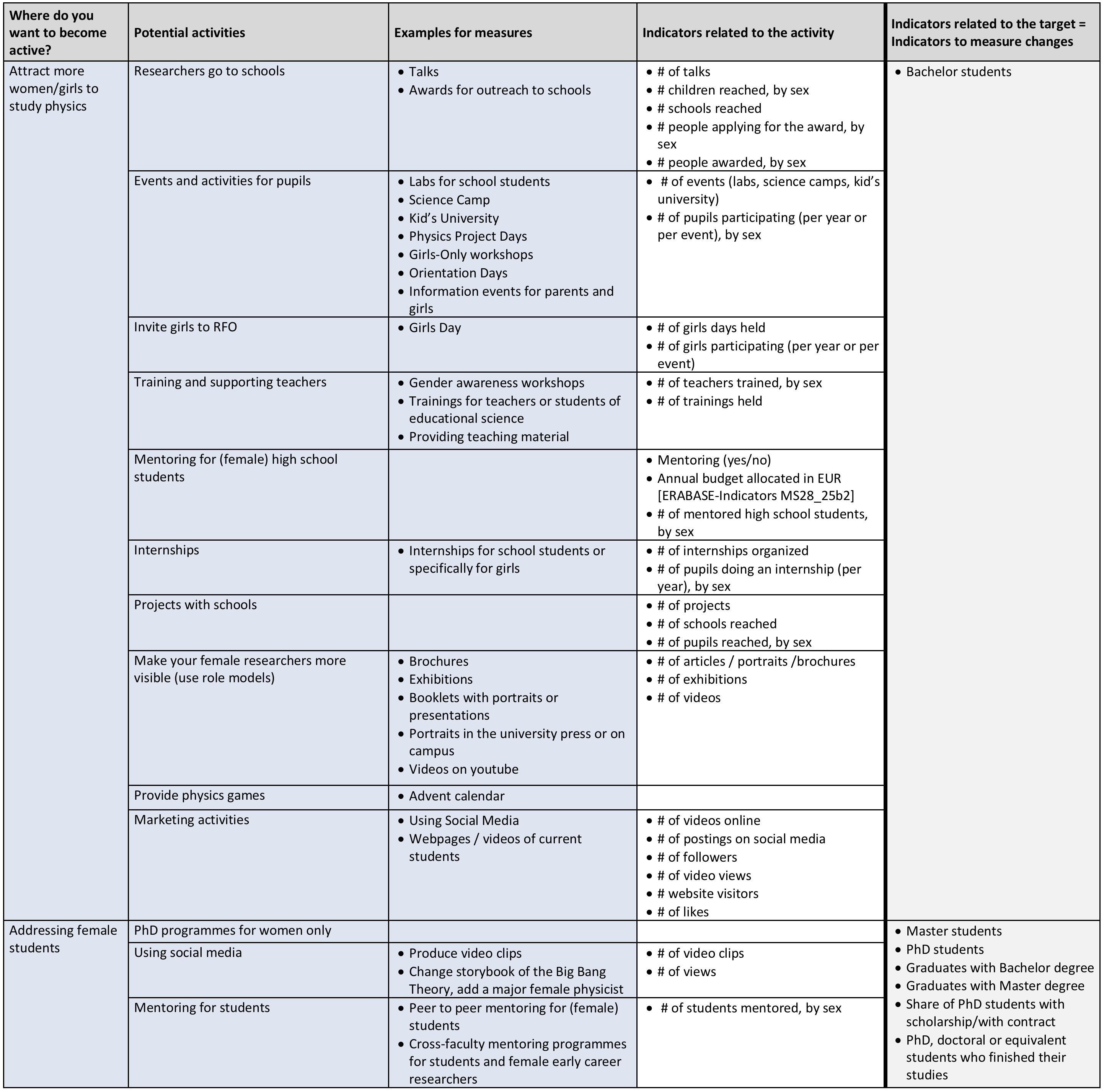Table of Contents
Background and aims of the PAM tool
1. Summary
Planning - Action - Monitoring
- The PAM Tool can be used to find measures, indicators and targets for Gender Equality Plans.
- The PAM Tool is a tool for monitoring as well as for guiding actions for more gender equality in physics.
- It is a tool for Implementation Managers and people responsible for the design and implementation of a GEP or Gender Equality Measures in research institutions in physics.
- The PAM Tool is intended to be used within organizations. All measures and indicators are defined from an organization’s view.
- The PAM Tool is work in progress. It is based on currently existing indicators as well as the experience of the authors.
2. Introduction
The GENERA monitoring tool was originally proposed to monitor the progress of GEPs at the level of each organization. As GEPs were not designed right in time to do so, it was agreed in the JS meeting in Vienna to develop an overall frame to monitor GEP progress - out of which each organization can choose measures and targets best fitting for their implementation work.
The resulting tool is not used to compare on a macro-level (like the WP5 Monitoring tool), but to monitor progress within a research organisation. The tool has been designed along the experiences that we as evaluation team made during the runtime of GENERA. It is therefore a tool based on the experiences in physics organisations and has been specifically conceptualized for physics.
Target groups are RFOs and RPOs in physics which are already active in planning and implementing gender equality measures and Gender Equality Plans (GEPs).
The accompanying evaluation of the GENERA project showed that it is a challenge for Implementation Managers to define targets and choose suitable measures. A vast amount of gender equality measures and targets can be found in toolboxes and literature. In praxis this creates a lot of confusions what to do or rather a complexity that needs to be structured - and the tool to structure it is the GENERA Action Tree, which links measures and targets.
The PAM tool, developed throughout the accompanying evaluation process consolidates experiences and expertise acquired throughout the project runtime. The development of the tool was aligned with the needs of the IMs and the research organizations' management, in order to provide orientation, systematization and causalities - crucial in the field of physics.
The following diagram illustrates the development of the PAM tool as outcome of the accompanying evaluation as Critical Friend who provides immediate support when needed. Figure 1: PAM tool as outcome of accompanying evaluation
Figure 1: PAM tool as outcome of accompanying evaluation
The PAM tool has two basic goals: it is an instrument for monitoring progress along the implementation of gender equality measures in physics, but it is also a tool for guiding actions for more gender equality in physics:
- Monitoring:
- The tool provides indicators to
- compare the situation before and after a period of intervention
- compare the situation between different organizations
- Guiding action:
- The tool gives directions for planning and implementing actions for more gender equality: it guides the reader from general targets to more specific targets, fields of interventions and finally measures which can be implemented.
- The tool also supports finding indicators to measure how actions impact gender equality targets. This can be used to control if organizations are making progress towards their targets and can also be used for (inter-) organizational learning about the effectiveness of measures.
- The action tree helps to ensure consistency between objectives and measures. Organizations can also use it as a blueprint to develop an individual and customized action tree.
Moreover, the GENERA Action Tree as a specific part of the PAM tool can be used for communication with the management and stakeholders. With its clear and simple structure it helps to reduce complexity when trying to convince decision makers or suggesting measures and targets to people in the organisation.
The structure of the PAM tool
The PAM tool is organized into two parts:
- The GENERA Action Tree is a visual overview of gender equality targets and provides a manual on how to use the tool. The tree can be understood as an answer to the request for guidance.
- Tables with indicators per target as well as per measure. When specific targets are already defined, the tool can help finding out which measures should be implemented to reach the formulated targets. The tool is additionally helpful for finding similar or alternative measures.
The PAM tool is structured in a logical order from ERA targets to measures:
 Figure 2: Logical structure of the PAM tool
Figure 2: Logical structure of the PAM tool
It is recommended to use the GENERA Action Tree for orientation and visualization and the tables for finding indicators and measures.
 Figure 3: GENERA Action Tree
Figure 3: GENERA Action Tree
 Figure 4: Tables with measures and indicators
Figure 4: Tables with measures and indicators
3. Methodology
The idea and content of the PAM tool is based on the results of the accompanying evaluation of the GENERA project. In order to structure complexity and to link gender equality targets and measures, we have established a logical order which starts with the ERA targets, breaks them down into more specific targets and finally links them to measures. The targets and sub-targets follow the idea of a logic model or also impact chain, i.e. sub-targets contribute to targets and targets contribute to ERA targets.
We have used the ERA targets as baseline to structure gender equality targets. The European Commission has defined five key priorities for the European Research Area (ERA) (European Commission 2012). Gender equality and gender mainstreaming in research is one of these priorities, broken down into three concrete targets. The ERA targets can be considered as main reference for gender equality targets on the European policy level.
The tool contains all Fields of Actions that have been identified in the Ex-ante assessment report (Deliverable D 3.2). Measures have been derived from the GENERA Toolbox and complemented with the knowledge of the authors. In cases where additional sources have been used, those are cited.
Indicators from various international data-sources (e.g. She figures 2015, GENDER-NET) have been collected and systematically linked to GENERA fields of interventions and measures. Some additional indicators were developed by the authors. A full list of all sources used can be found in chapter 6.
Several draft versions have been reviewed by the GENERA Implementation Managers in order to ensure usability and completeness of the tool.
The PAM tool is a comprehensive tool to guide and monitor action for more gender equality in Physics. However, the tool has also limitations:
- This tool can be considered work in progress. It is based on publicly available indicators as well as on the experience of the authors. For some measures/targets no indicators are available to our knowledge. We hope to further improve and complete the existing collection of measures and indicators.
- The focus of this tool is on structure. We want to offer a taxonomy that helps to plan and monitor. The focus of the tool is not on measures, functionality of measures, and content of measures or linkage to the individual institution.
- Relations between measures and targets as well as between targets are complex and interdepending. In order to reduce complexity and offer a tool that can be used and handled in practice, the tool describes causalities between measures, sub-targets and targets which must be considered as simplified.
4. Guideline for using the PAM tool
This chapter explains how to work with the PAM tool and how to use it to find measures, indicators and targets for Gender Equality Plans (GEPs). The PAM tool is for Implementation Managers and people responsible for the design and implementation of Gender Equality Plans in research institutions in physics. Therefore, this chapter is specifically directed to Implementation Managers.
You can use the PAM tool to…
I. Design your GEP or Gender Equality Measures
The PAM tool and especially the GENERA Action Tree as visual overview provide easy instructions for GEP design. With the help of the tool you can:
- Find measures - When you have already defined specific targets, you can use the tool to find out: Which measures should be implemented to reach the targets? You can also use the tool to find similar / alternative measures to reach the same target.
- Find targets - The tree contains an overview of potential targets in the area of gender equality. This helps you to answer the question: What should be in a GEP? When gender equality measures are already planned or implemented, you can use the tree to find out: Which results can be expected? You can also use it to define targets.
- Structure your GEP - Structure the measures you already have (in mind) and link them to targets. You can also design your individual action tree.
- Find out where “blind spots” are, i.e. which aspects of gender equality you are not addressing in your GEP.
- Use indicators to find out where the problem is.
II. Monitor your activities and progress
- Find indicators and monitor the impact of your gender equality measures, in other words: monitor progress/change.
“Helpi” helps you

appears from time to time to mark the most important statements.
